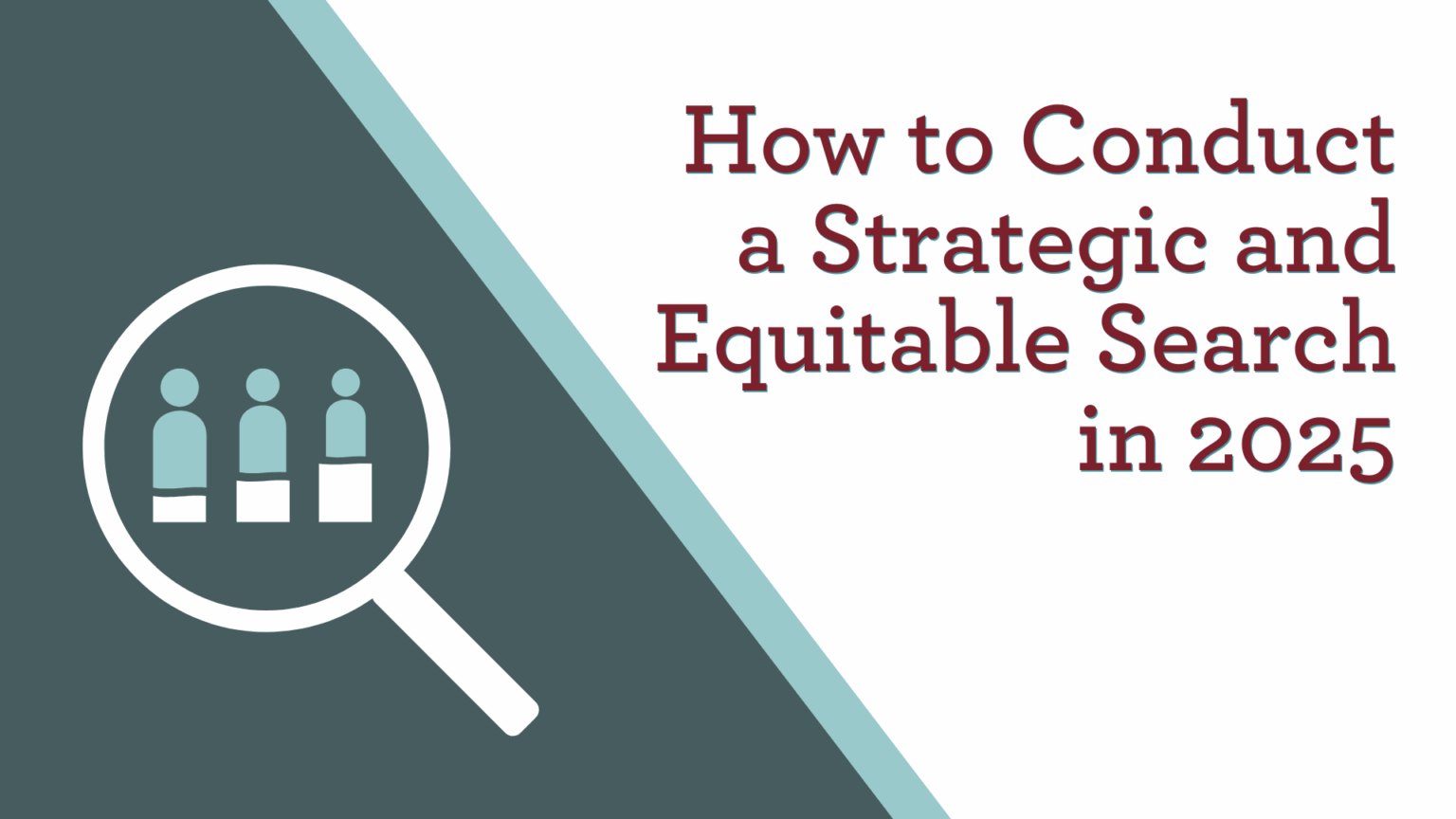Adam Fazio
Vice President
Leadership transitions are critical change moments for organizations. In 2025, as nonprofits navigate economic uncertainty, evolving workforce challenges, and heightened scrutiny around how to talk about equity, these transitions carry even greater weight. Many executives and boards are tempted to respond by hiring a new leader as quickly as possible. However, skipping or truncating the search process rarely produces an ideal result.
To ensure your next leader is well positioned to move your organization forward, you need to take a step back and assess your strategic direction. You can’t afford to begin the process of recruiting, interviewing, and selecting your next leader or high-impact team member until you are aligned around the needs of the role and vision for where the organization is heading.
Assess Your Nonprofit's Needs and Strategic Direction
When an executive leader, chief development officer, or other integral employee leaves, it’s natural to reach for the same materials you’ve used in the past and post the position as soon as possible.
We recommend pausing to reassess before you begin the hiring process. Otherwise, you may end up hiring someone whose skills and experience look identical to the person who just left. Worse, you’ll end up evaluating candidates based on past performance.
That might not sound like a problem if the person who left was a high performer. But what if your organization’s needs have evolved? What if the skills you valued in the past aren’t sufficient for where you want to go in the future?
Engage in a Robust Discovery Process
Getting to the heart of an organization’s needs requires an objective and inquisitive mindset. An outside consultant will ask good questions, probe beneath the surface, and uncover the competencies the role requires.
Benefactor Group begins every search engagement with an in-depth, far-reaching discovery process. This involves holding a combination of one-on-one interviews, focus groups, and community surveys with:
- Board members and executive leaders
- The outgoing leader/employee
- Team members who report to—or work closely with—the position in question
- Key donors, volunteers, and supporters
- Community partners and leaders
- Staff members throughout the organization
With each group, we explore questions like:
- What is the vision for the organization in the next three to five years?
- What will it take to accomplish that vision?
- How would you describe the culture of the organization and that of the department?
- What is the physical environment of the office like?
- How do individuals and teams interact with each other?
- How are decisions made and what role does this position play in making decisions?
- What are the biggest successes the team has accomplished?
- How do you celebrate wins?
- How does the team handle perceived failure and disappointment?
- What types of challenges and opportunities will the person in this position face?
Through countless engagements, we’ve learned what it takes to gather input and foster support in times of transition.
Identify the Skills and Core Competencies that are Essential to the Position
Once you’ve assessed your organizational needs and strategic direction, it’s time to narrow in on the core competencies the role requires. Hiring with a specific vision in mind can re-shape your perspective on what success looks like.
For example, say you’re replacing a successful development officer with a track record of securing major gifts. The person met their fundraising targets each year, but did so by cultivating relationships with only the wealthiest donors in their portfolio.
That’s a legitimate way to reach fundraising goals. But what if your organization needs to broaden your base of support and develop a better balance of mega, major, middle, and modest gifts? You’ll want to hire someone who is skilled in research and knows how to grow a healthier, long-term pipeline.
There are many ways for leaders to approach their work and achieve success. Be sure to prioritize the methods, attitudes, and habits that align with your organization’s overarching goals.
Provide a Realistic Preview in Position Descriptions
In executive search, the position description does more than outline a set of responsibilities. It sets the tone for how candidates perceive the role, the organization, and their potential for impact. The most effective descriptions are those that strike a balance: they highlight the possibilities for leadership while also being candid about the challenges that come with the work.
Today’s candidates are looking beyond lists of qualifications. They want to understand the environment they are stepping into, the culture they will inherit, the resources at their disposal, the expectations of the board, and the goals they will be accountable for achieving. When a position description acknowledges realities, whether it is the need to diversify revenue, navigate a changing workforce, or lead through a period of transition, it creates credibility. It signals that the organization is ready for an authentic leader who can address those challenges.
This same principle applies to how organizations message about their commitments to diversity, equity, and inclusion. Even as some state and federal policies restrict explicit DEI language, employers can still ground their descriptions in values. By focusing on behaviors such as building respectful and collaborative teams, ensuring equitable access to programs, or leading with cultural humility, organizations communicate what they truly expect from their leaders. Candidates who share these values will recognize themselves in the description, while those who do not will often self-select out.
This kind of transparency does not diminish interest; it deepens it. Leaders are drawn to opportunities where their skills can meet real needs. A description that pairs organizational aspirations with an honest preview of the current landscape inspires candidates to imagine how they could make a lasting difference. Rather than attracting the most applicants, it attracts the right ones, those who see both the weight of responsibility and the potential for meaningful change.
Ultimately, a position description is an invitation. By telling the whole story, opportunities and obstacles alike, organizations do more than advertise a vacancy; they begin building alignment with the leader who will guide their future.
Reevaluate Qualifications
Old job descriptions often include unnecessary barriers. Does a nonprofit leader really need to lift 50 pounds, hold a bachelor’s degree, or log ten years in the field?
Focusing on skills and behaviors rather than credentials expands the candidate pool and leads to more equitable, effective hiring.
Utilize Proactive Search Techniques to Recruit Top Talent
Many of the best candidates simply aren’t in the market for a new position. To that end, you can’t sit back and expect top applicants to approach you.
A good consultant will have:
- The ability to tap into a large, well-established network of nonprofit professionals in a variety of sectors;
- Proven skills in modern search techniques, including specialty certifications in areas such as diversity-focused recruitment;
- Time to devote to contacting candidates, speaking with them about the role one-on-one, and inviting them to apply;
- Sector expertise and an ability to articulate the opportunities and challenges in a way that provides the candidate a realistic preview of the role; and
- Insight into ways your organization might be communicating unconscious bias or a non-welcoming atmosphere to members of underrepresented and marginalized groups.
It’s also worth mentioning that when you do find an ideal candidate to fill your open position, it’s wise to move quickly to make the offer. In the corporate world, if a rockstar with all the right skills and characteristics applies for a job, hiring managers expedite the process. They don’t risk losing an exceptional candidate to fast-moving competitors.
By contrast, nonprofits sometimes overthink the process unnecessarily. A consultant who understands the nonprofit hiring landscape can help you know when to move quickly and when to search further.
Expand Your Network
Attracting top talent requires nonprofits to proactively and aggressively reach out to candidates far and wide. An experienced, well-connected executive search partner can make this process far less daunting.
Establish Objective Measurement Criteria to Overcome Implicit Biases
People naturally gravitate toward those who are most like them. This is an example of what’s called affinity bias. If you’re not aware of its power, you may choose candidates who feel familiar and comfortable even if they’re not best-suited for the role.
Think about the last time you interviewed a pool of candidates for a position. You were likely drawn to those with whom you felt an easy rapport. Unfortunately, in most cases the notion of rapport strongly favors people who were brought up in dominant contexts. And if your organization is largely homogenous, the people on your search committee are less likely to feel affinity for members of your applicant pool who aren’t like them.
You can combat implicit biases with a structured, uniform process and objective criteria for screening, rating, and selecting candidates.
Utilize Validated Techniques Such as Behavioral Interviewing
Behavioral interviewing is a validated technique that helps ensure a fair and equitable process for all candidates. It enables interviewers to avoid hiring based on a gut feeling or intuition.
Past actions are an excellent indicator of future behavior. Therefore, behavioral interviewing asks candidates to share specific examples of how they’ve previously handled a variety of scenarios and situations. For example, a typical interview question might ask a candidate to describe how they resolve conflicts at work. By contrast, a behavioral interviewer might invite the candidate to share a time they had a disagreement with a colleague about a project’s strategic direction and describe how they handled it.
The latter approach results in a more well-rounded answer and more in-depth insight into how the candidate will approach their role.
Establish Objective Rating Criteria
The best way to keep candidates on a level playing field is to rate them based on a consistent set of criteria everyone agrees to at the outset. Of course, the measurement criteria should point back to the skills and competencies you identified as essential for success in the discovery process.
In a search process led by Benefactor Group, each person who participates in the interview process anonymously submits ratings prior to having a conversation about their perceptions of the candidate. From there, our search team scores and ranks each candidate based on the aggregate ratings provided. Then, we evaluate whether or not the interview team’s feelings about the interviewees match the data.
If there are discrepancies between how the group feels about a candidate versus what the data shows, we facilitate a frank discussion to explore that disconnect. This enables the group to acknowledge and address any implicit biases and make a decision that’s in line with the organization’s needs and strategic priorities.
Invest in a Well-Structured Search to Set Your Nonprofit Up for Success
Whether you’re searching for a CEO or recruiting the fundraisers who will steward your organization’s most fruitful relationships, hiring the right person to fill the open position is paramount.
Therefore, it’s vital to invest in a strategic and equitable process. Take time to assess your organization’s needs through the lens of your strategic direction. Identify the skills and competencies you require to execute that vision. And engage in a thorough, welcoming search process that invites diverse and qualified candidates to the table.
Benefactor Group understands the unique pressures nonprofit organizations experience in the quest for top talent. We’ve helped many clients navigate the search process and find the right leader to move their organization forward. We’d love to help you too—just reach out.





